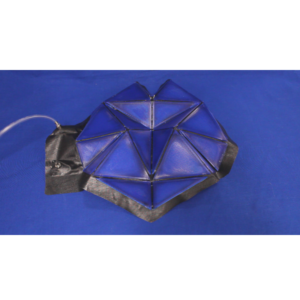
Morphing surfaces, with the ability to actively change shape have applications ranging from variable-wing aircraft, adaptive automotive surfaces, and user-interactive devices. A large variety of smart structures have been studied to provide this functionality including traditional rigid mechanisms, compliant mechanisms, and smart material composites, presenting varying tradeoffs between weight, mechanical complexity, and extreme shape changing ability. An emerging technological structure, origami structures, holds the promise to enhance morphing surface applications, but typical origami-based structures rely either on bulky discrete actuators to provide large motions, or are limited in the motions provided by more compact distributed forms of actuation such as smart materials. A promising new actuation approach under development is a tile-based morphing air surface which uses flat-packaged inflatable bladders to produce moments distributed along hinges with significant actuation authority without additional packaging volume beyond the origami tile panels themselves. This work will explore the use of such flat-packaged air structures to enhance self-actuating origami structures by examining the modeling and design issues involved in producing large-scale motions with significant torque when distributed throughout an folds of an origami structure. First-principles models of the moment-angle actuation properties will be developed and experimentally validated to support the design of self-folding hinges. Through proper distribution of active and passive tile hinges, the coupled kinematics of the entire origami structure will be exploited to leverage the strengths and mitigate the weaknesses of this novel actuation in a model-based design approach. In addition, the use of multiple opposing actuated hinges throughout the structure to create antagonistic actuation capable of continuously controlling displacement and stiffness of the entire structure will be explored. The resulting technology, models, and design methods will enable controllable, lightweight, extremely low-profile origami structures capable of large shape-changing deformations. As a potential key technology behind a wide range of applications, the work can form the foundation of proposals to a number of possible sponsors including industrial (automotive companies for external aero surfaces), NASA (space deployable structures), NIH (medical and disability assistive devices), and NSF (as a general enabling technology).
People

Jonathan
Luntz
ME
Engineering

Diann
Brei
ISD, ME
Engineering
Funding

Funding: $30K (2023)
Goal: The goal of this project is to develop the technology and supporting science for the model-based design of controllable, lightweight, extremely low-profile pneumatically self-actuated origami structures to form the technological basis of morphing surface applications.
Token Investors: Jonathan Luntz and Diann Brei
Project ID: 1110
